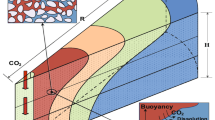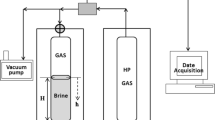Abstract
To investigate long-term CO2 behavior in geological formations and quantification of possible CO2 leaks, it is crucial to investigate the potential mobility of CO2 dissolved in brines over a wide range of spatial and temporal scales and density distributions in geological media. In this work, the mass transfer of aqueous CO2 in brines has been investigated by means of a chemical potential gradient model based on non-equilibrium thermodynamics in which the statistical associating fluid theory equation of state was used to calculate the fugacity coefficient of CO2 in brine. The investigation shows that the interfacial concentration of aqueous CO2 and the corresponding density both increase with increasing pressure and decreasing temperature; the effective diffusion coefficients decrease initially and then increase with increasing pressure; and the density of the CO2-disolved brines increases with decreasing CO2 pressure in the CO2 dissolution process. The aqueous CO2 concentration profiles obtained by the chemical potential gradient model are considerably different from those obtained by the concentration gradient model, which shows the importance of considering non-ideality, especially when the pressure is high.
Similar content being viewed by others
References
Bachu S. Sequestration of CO2 in geological media: Criteria and approach for site selection in response to climate change. Energy Convers. Manage, 2000, 41: 953–970
Schrag DP. Preparing to capture carbon. Science, 2007, 315: 812–813
Firoozabadi A, Cheng P. Prospects for subsurface CO2 sequestration. AIChE J, 2010, 56: 1398–1405
Bruant RG Jr, Guswa AJ, Celia MA, Peters CA. Safe storage of CO2 in deep saline aquifers. Environ Sci Technol, 2002, 36: 240A–245A
Hassanzadeh H, Pooladi-Darvish M, Keith DW. Accelerating CO2 dissolution in saline aquifers for geological storage — Mechanistic and sensitivity studies. Energy Fuels, 2009, 23: 3328–3336
Bachu S, Adams JJ. Sequestration of CO2 in geological media in response to climate change: Capacity of deep saline aquifers to sequester CO2 in solution. Energy Convers Manage, 2003, 44: 3151–3175
Michael K, Golab A, Shulakova V, Ennis-King J, Allinson G, Sharma S, Aiken T. Geological storage of CO2 in saline aquifers — A review of the experience from existing storage operations. Int J Greenh Gas Con, 2010, 4: 659–667
Yang C, Gu Y. Accelerated mass transfer of CO2 in reservoir brine due to density-driven natural convection at high pressures and elevated temperatures. Ind Eng Chem Res, 2006, 45: 2430–2436
Gilfillan SMV, Lollar BS, Holland G, Blagburn D, Stevens S, Schoell M, Cassidy M, Ding Z, Zhou Z, Lacrampe-Couloume G, Ballentine CJ. Solubility trapping in formation water as dominant CO2 sink in natural gas fields. Nature, 2009, 458: 614–618
Keith DW, Giardina JA, Morgan MG, Wilson EJ. Regulating the underground injection of CO2. Environ Sci Technol, 2005, 39: 499A–505A
Oldenburg CM. Transport in geologic CO2 storage systems. Transp Porous Med, 2010, 82: 1–2
Weir GJ, White SP, Kissling WM. Reservoir storage and containment of greenhouse gases. Energy Convers Manage, 1995, 36: 531–534
Teng H, Yamasaki A. Mass transfer of CO2 through liquid CO2-water interface. Int J Heat Mass Transfer, 1998, 41: 4315–4325
Ogasawara K, Yamasaki A, Teng H. Mass transfer from CO2 drops traveling in high-pressure and low-temperature water. Energy Fuels, 2001, 15: 147–150
Arendt B, Dittmar D, Eggers R. Interaction of interfacial convection and mass transfer effects in the system CO2-water. Int J Heat Mass Transfer, 2004, 47: 3649–3657
Farajzadeh R, Salimi H, Zitha PLJ, Bruining H. Numerical simulation of density-driven natural convection in porous media with application for CO2 injection projects. Int J Heat Mass Transfer, 2007, 50: 5054–5064
Farajzadeh R, Barati A, Delil HA, Bruining J, Zitha PLJ. Mass transfer of CO2 into water and surfactant solutions. Pet Sci Technol, 2007, 25: 1493–1511
Farajzadeh R, Zitha PLJ, Bruining J. Enhanced mass transfer of CO2 into water: Experiment and modeling. Ind Eng Chem Res, 2009, 48: 6423–6431
Kneafsey TJ, Pruess K. Laboratory flow experiments for visualizing carbon dioxide-induced, density-driven brine convection. Transp Porous Med, 2010, 82: 123–139
Kocherginsky N, Zhang YK. Role of standard chemical potential in transport through anisotropic media and asymmetrical membranes. J Phys Chem B, 2003, 107: 7830–7837
Liu C, Ji Y, Shao Q, Feng X, Lu X. Thermodynamic analysis for synthesis of advanced materials. Molecular thermodynamics of complex systems. Struct Bond, 2009, 131: 193–270
Ji YH, Ji XY, Liu C, Feng X, Lu XH. Modelling of mass transfer coupling with crystallization kinetics in microscale. Chem Eng Sci, 2010, 65: 2649–2655
Lu XH, Ji YH, Liu HL. Non-equilibrium thermodynamics analysis and its application in interfacial mass transfer. Sci China Chem, 2011, 54: 1659–1666
Ji XY, Tan SP, Adidharma H, Radosz M. SAFT1-RPM approximation extended to phase equilibria and densities of CO2-H2O and CO2-H2O-NaCl systems. Ind Eng Chem Res, 2005, 44: 8419–8427
Ji YH, Ji XY, Feng X, Liu C, Lu LH, Lu XH. Progress in the study on the phase equilibria of the CO2-H2O and CO2-H2O-NaCl systems. Chin J Chem Eng, 2007, 15: 439–448
Adidharma H, Radosz M. Prototype of an engineering equation of state for heterosegmented polymers. Ind Eng Chem Res, 1998, 37: 4453–4462
Adidharma H, Radosz M. Square-well SAFT equation of state for homopolymeric and heteropolymeric fluids. Fluid Phase Equilib, 1999, 158: 165–174
Tan SP, Adidharma H, Radosz M. Statistical associating fluid theory coupled with restricted primitive model to represent aqueous strong electrolytes. Ind Eng Chem Res, 2005, 44: 4442–4452
Ji XY, Tan SP, Adidharma H, Radosz M. Statistical associating fluid theory coupled with restricted primitive model to represent aqueous strong electrolytes: Multiple-salt solutions. Ind Eng Chem Res, 2005, 44: 7584–7590
Prausnitz JM, Lichtenthaler RN, de Azevedo EG. Molecular Thermodynamics of Fluid-phase Equilibria (3rd edition). New Jersey: Prentice Hall PTR, 1999
Crank J. The Mathematics of Diffusion (2nd edition). Oxford: Clarendon Press, 1975
Tewes F, Boury F. Formation and rheological properties of the supercritical CO2-water pure interface. J Phys Chem B, 2005, 109: 3990–3997
Frank MJW, Kuipers JAM, van Swaaij WPM. Diffusion coefficients and viscosities of CO2 + H2O, CO2 + CH OH, NH3 + H2O, and NH3 + CH3OH liquid mixtures. J Chem Eng Data, 1996, 41: 297–302
Rowley RL, Adams ME, Marshall TL, Oscarson JL, Wilding WV, Anderson DJ. Measurement of diffusion coefficients important in modeling the absorption rate of carbon dioxide into aqueous N-methyldiethanolamine. J Chem Eng Data, 1997, 42: 310–317
Author information
Authors and Affiliations
Corresponding author
Rights and permissions
About this article
Cite this article
Ji, Y., Ji, X., Lu, X. et al. Modeling mass transfer of CO2 in brine at high pressures by chemical potential gradient. Sci. China Chem. 56, 821–830 (2013). https://doi.org/10.1007/s11426-013-4834-8
Received:
Accepted:
Published:
Issue Date:
DOI: https://doi.org/10.1007/s11426-013-4834-8




